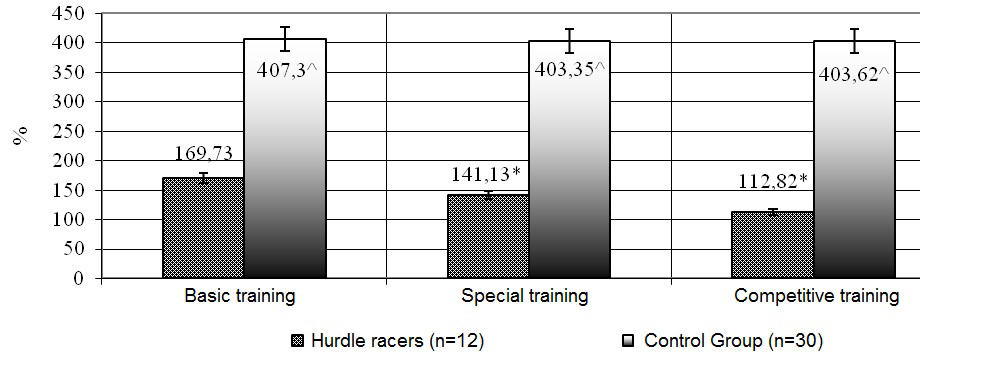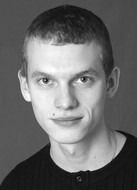Postural control physiology specifics in elite hurdle racers due to long-term motor specialization
Фотографии:
ˑ:
Postgraduate student A.A. Semchenko1
Dr.Biol., Associate Professor A.V. Nenasheva1
PhD, Associate Professor I.V. Izarovskaya1
PhD, Associate Professor Е.В. Zadorina1
Post-graduate student E.F. Baymukhametova1
1South Ural State University (National Research University), Chelyabinsk
Keywords: hurdle race, postural balance, statokinetic stability, stabilometry, statokinesiogram, training and competitive system.
Introduction. It is well known that cumulation of vestibular analyzer stimuli of varying intensity is typical for the vast majority of sports specializations [4]. Moreover, there is an acute problem throughout the process of effective motor performance associated with the emergence of an additional limiting condition consisting in the combined influence of muscular and vestibular loads [3]. In this regard, the postural control physiology specifics (mainly, vestibular sensory and vestibular somatic reflexes) are primarily taken into account when designing the training and competitive system in sports characterized by complex vectors in kinematics of motor actions [6].
The search for the solution to the problem of successful motor acts performance in terms of high vestibular load is reflected in the works of a number of researchers who unanimously emphasize the need for the development in athletes of a special ability – statokinetic stability [1, 5, 7]. Excessive training loads in hurdle racing, associated with asymmetric muscular strength, can act as a factor that limits the formation of physiologically neurological organization of postural balance, which will negatively affect the significant static/ kinetic stability rates [2].
Objective of the study was to identify the postural control physiology specifics in elite hurdle racers using computerized stabilometry.
Methods and structure of the study. The work was carried out at the premises of the Science Center for Physical Culture and Sport of the Institute of Sport, Tourism and Service of SUSU (National Research University). Subject to the study were 12 elite hurdle racers, who participated in the tests on a voluntary basis (2 World Class Athletes, 3 Masters of Sport of the Russian Federation, 4 Candidate Masters of Sport and 3 athletes with the 1st senior category). The mean age was 22.8±0.25, the average specialization period in hurdle racing was 9.14±0.02 years. The Control Group was made of 30 males of mature age, the 1st and 2nd year students of the master's degree program.
The studies were conducted using the stabilometric platform "MBN Stabilo" (Moscow, registration certificate No. FS 29/03010403/ 5416-03 dated July 2, 2003), which meets standard international requirements by its technical characteristics [4].
Results and discussion. Figure 1 illustrates the sensor-vestibular test results in the surveyed hurdle racers and Control Group subjects that characterize the integral criterion of performance of visual proprioception - the Romberg’s coefficient.

Figure 1. Romberg’s test rates in hurdle racers in training and competitive process dynamics
Note: ^ – р≤0.001 – significance of differences between hurdle racers and Control Group subjects; * – р≤0.05 – significance of differences at all stages of the experiment.
The Romberg’s test rates in the elite hurdle racers were statistically significantly lower than those in the males of the Control Group throughout the whole period of study (p≤0.001). The Romberg’s coefficient (RC) in the surveyed hurdle racers significantly reached the value of 100% of the basic training stage by the stage of peak competitive fitness, which indicated an abnormal increase in the stability of the vertical postural control, which was probably due to a decrease in the contribution of the visual analyzer to the postural control when improving the mechanisms of adaptation of motor proprioception to the optokinetic stimulation in the form of visual information of the forthcoming hurdle.
At the special skills excelling stage, the position of the common center of pressure (CCP) in the frontal plane in the eyes open (O-E) and eyes closed (C-E) tests tended to shift towards the take-off foot (p≤0.01-0.001), which testified to asymmetric loading on the right and left parts of the hurdle racers’ body.
In the competitive period, probably due to more evenly redistributed strength and speed-strength loads between the contralateral links of the motor profile of the examined hurdle racers, relative compensatory stabilization of the pronounced deviations in the position of CCP was observed. The primary motor strategy of the hurdle racers in the dynamics of the training and competitive system was the ankle strategy of maintaining the postural balance. It should be noted that at the special training stage the position of the CCP in the sagittal plane shifted forward significantly in the following tests: head turning right test (by 9.04 mm at p≤0.001) and head turning left test with EC (by 7.97 mm at p≤0.05). This feature does not indicate any violation of the physiological mechanism of formation of statokinetic stability in the hurdle racers, but indicates uneconomic energy consumption in order to keep balance when performing a competitive action.
According to the tests, the CCP movement rate in the elite hurdle racers gradually decreased, reaching the normal level with a confidence interval for the European posture (p≤0.05). We believe this feature evidences the leveling of tension of compensatory mechanisms, which ensure the accuracy of the corrective postural responses in the hurdle racers when attacking and jumping over the hurdle (when their lower and upper limb position approaches the body center of mass (BCM), when they maintain rational height of BCM above the hurdle, etc.).
At the basic training stage, the area of statokinesiogram in the group of hurdle racers was close to the physiological norm for the population of mature aged males (p≤0.05) (99.5 mm2 in the EO tests, 258.4 mm2 in the EC tests). The basic and special training of the hurdle racers within the training and competitive system was characterized by significantly higher indices of the area of statokinesiogram when performing the head turning right tests (p≤0.05). At the competitive training stage, the studied indicator leveled out, which was associated with the sensory system stimulation (in all tests, except for the main stance with EO) (p≤0.05).
Throughout the period of testing of the hurdle racers, the spectral power in the frontal (fx) and sagittal (fy) planes had a common tendency to increase in terms of the slow high-amplitude frequency oscillations (from 0 to 0.3 Hz) at the special skills excelling stage (p≤0.05) and escalate in terms of the medium-frequency amplitudes (from 0.5 to 1.5 Hz) as the specific competitive loads increased (p≤0.05-0.01). The stabilometry tests of the hurdle racers with the sensor-vestibular tests in the training and competitive processes showed low variations in these static/ kinetic balance rates. In theoretical terms, this qualifies as a criterion for developing in hurdle racers with long-term motor specialization long-term compensatory reactions directed towards maintenance of the statokinetic stability under changing characteristics of perception of the body position (static component) and direction sense, spatial body movement speed (kinetic component) being influenced by the load intensity at each stage of the training and competitive process.
Conclusions. The detected functional changes in the static/ kinetic stability rates are indicative of the cross motor stereotypes being formed in the hurdle racers under specific training and competitive loads, with the counter-lateral synchronization of the relevant proprioceptors and myotatic reflexes. In addition, the study data and analysis of the stabilograms and statokinesiograms is highly beneficial for the hurdle racers’ training and competitive process correction. Thus, at the special skills excelling stage when the slow high-amplitude oscillating movements are trained, it is recommended to apply special stands with or without balancing weights to improve the static component of the static/ kinetic balancing skills.
References
- Saraykin D.A., Epishev V.V., Pavlova V.I. et al. Dinamika posturalnogo balansa v vertikalnoy poze tkhekvondistov vysokoy kvalifikatsii v godovom makrotsikle [Dynamics of postural balance in vertical position of highly-skilled taekwondokas in annual macrocycle]. Human. Sport. Medicine, 2017, vol. 17, no. 3, pp. 25–34.
- Semchenko A.A., Nenasheva A.V. Trend izmeneniy stepeni tolerantnosti organizma bareristov k fizicheskoy nagruzke v razlichnye fazy trenirovochno-sorevnovatelnoy podgotovki [Tendency of changes in exercise tolerance in hurdlers at different stages of training and competitive conditioning]. Human. Sport. Medicine, 2017, vol. 17, no. 2, pp. 89–93.
- Sliva S.S. Otechestvennaya kompyuternaya stabilografiya: tekhnicheskiy uroven, funktsionalnye vozmozhnosti i oblasti primeneniya [Home computer stabilography: technical level, functional potentialities and spheres of application]. Medical equipment. Moscow: Meditsina publ., 2005, pp. 32–36.
- Strelets V.G., Gorelov A.A. Teoriya i praktika upravleniya vestibulyarnymi reaktsiyami cheloveka v sporte i professionalnoy deyatelnosti [Theory and methods of vestibular reaction control in sports and professional activity]. St. Petersburg, 1995, 150 p.
- Gribble P.A., Hertel J. Effect of lower-extremity muscle fatigue on postural control. Archives of Physical Medicine and Rehabilitation, 2004, vol. 85, pp. 589–592.
- Gu J., Xu J., Tu L. Discuss teaching model of quality teaching about hurdle teaching which is major in track & field of physical education. Journal of Suzhou University, 2007, vol. 2, pp. 92–94.
- Epishev V.V., Ryabina K.E., Isaev A.P., Erlikh V.V. Postural balance in middle-distance runners. Russian Journal of Biomechanics. 2017, vol. 21, no. 2: 144-154.
Corresponding author: semchenkoaa@cspu.ru
Abstract
The study applied a computerized stabilometry system to analyze the postural control physiology specifics in elite hurdle racers (n=12) and found variations in the static/ kinetic stability rates indicative of the cross motor stereotypes being formed under specific training and competitive loads, with the counter-lateral synchronization of the relevant proprioceptors and myotatic reflexes. The study data and analysis of the stabilogram and statokinesiograms may be highly beneficial for the hurdle racers’ training and competitive process correction. At the special skills excelling stage when the slow high-amplitude oscillating movements are trained, it is recommended to apply special stands with or without balancing weights to improve the static component of the static/ kinetic balancing skills. The study data showed the precompetitive redistribution of the performance oscillations in the elite hurdle racers’ stabilograms with domination of the medium-frequency amplitudes in the frontal and sagittal planes that may be indicative of the high balance in the specific kinematic chain (movement sequence). The stabilometry tests of the hurdle racers with the sensor-vestibular tests in the training and competitive processes showed low variations in the key static/ kinetic balance rates including dynamic balance ratio, stability index and stability rate.



